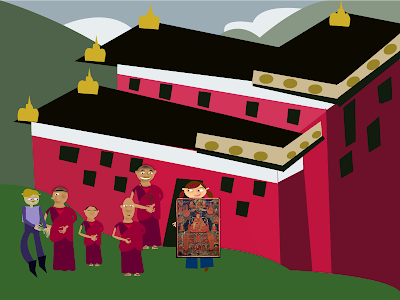More exciting than making my way through the artwork in 2 days..ahem... was really coming up with a more exciting spin on the concept for the game. Basically the idea is to mix historical facts, visual clues and quiz based games with thematic strategy silly games. Here is my run down. The idea of a storyboard was daunting to me because I really just wanted to write out a script of sorts, so that's what I did:
1. INTRO SCREEN (WEBSITE) Click on play window
2. MAP SCREEN- choose Tibet (level)
3. CLIPBOARD SCREEN- get clipboard- clipboard has note saying that you should start in Tibet to see if you can find any clues in the original location. The monastery is in the hills of the Tibetan countryside, the easiest way to get there is to try to find a monk in the food market in the center of town.
4. MARKETPLACE SCREEN- go to the center of town- the market
first search for the monk.
lots of people.
ask around by clicking on people to start a conversation
yak herder- oh well, why would you want to go to THAT monastery? The art
was completey stolen during the Cultural Revolution! The walls are stripped!
If I were you I would ask the hat seller. You are going to need a good hat if you are
travelling up there!
Hat seller. These are the kind of hats Tibet is known for. Would you like to buy one?
He will not talk to you unless you buy a hat. If you choose to not buy the hat, you get shoed away.
if you do buy hat, he tells you that the monk is buying dri milk.
(distraction room -karaoke bar where people are singing and dancing to Nangma dance music
game following the dance moves and play along the intricate beat (ala ddr).)
monk is untrusting, tests your knowledge on Tibet:
click on items that are Tibetan...
Monk leads you to mountain.
5.MOUNTAIN SCREEN-need to click on things. when the yak falls a yak herder comes by to help. She first says that you need to be careful... yaks are very important to Tibetans.
I need to watch out for all my yaks... particularly after the monastery was attacked! Luckily some of the art was smuggled to America.
So! Lets figure out how to get you up the mountain.
Well I know a special route but listen, you have to be careful for the yeti. Although it's just a legend.... he's rumored to be hanging around these hills!
game of climbing up the mountain and avoiding the yeti and falling rocks.
6. EXTERIOR MONASTERY SCREEN- you make it to the monastery. another monk. another set of questions about Tibet-
Geography quiz
7.INTERIOR MONASTERY SCREEN- you get into monastery
need to make the mandala to get the key
You can take
the key opens the box
the box has a map of NY and then a picture of Times Square, a flier from the Latse Library. You decide to go to NY. The monk with the key tells you that you are going to need a good luck charm and gives you a khata
------------ this is where I stopped for the purpose of completion, but in theory then you would go to NY, Times Sq, then Latse, then to a dealer, then to a collector, then to grandchildren.
Side note: throughout the game there will be good luck charms that can be collected for points. I haven't figured out how that is going to play into the overall game yet. I think also you can get points based on your quiz scores etc.
HERE ARE SOME PROGRESS IMAGES:

INTRO SCREEN

MAP SCREEN

CLIPBOARD SCREEN

MOUNTAIN SCREEN

EXTERIOR SCREEN

INTERIOR MANDALA SCREEN
































